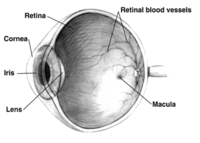
Photo from wikipedia
Objective To assess the presence of retinal vascular network abnormalities in amnestic mild cognitive impairment (aMCI) patients and healthy subjects (HS) through optical coherence tomography angiography (OCTA). Methods OCTA and… Click to show full abstract
Objective To assess the presence of retinal vascular network abnormalities in amnestic mild cognitive impairment (aMCI) patients and healthy subjects (HS) through optical coherence tomography angiography (OCTA). Methods OCTA and SD-OCT were performed in aMCI patients and cognitive normal HS. A complete neuropsychological evaluation was performed. Differences in vessel density (VD) in each retinal vascular plexus and in foveal avascular zone (FAZ) were evaluated with linear mixed model after correction for age, sex and disease duration. Results Twenty-seven aMCI patients (10 Single domain aMCI, 17 Multidomain aMCI) and 29 HS were enrolled. aMCI patients showed a statistically significant reduced VD in superficial capillary plexus (SCP), deep capillary plexus (DCP) and an increased FAZ compared to controls. When aMCI patients were divided in single domain (SD) and multiple domains (MD) aMCI, SD aMCI showed no VD differences in SCP, DCP and Radial Peripapillary Capillary, while the FAZ area was significantly larger compared to controls. In MD aMCI, VD values were lower and FAZ was increased compared to controls. Comparing both aMCI groups, MD aMCI showed a significant reduction in VD values of SCP. No correlation was found between mini mental state examination (MMSE) scores and OCTA parameters. Conclusions OCTA is able to detect changes in retinal microvascular network in early cognitive deficits and, the most sensitive alteration seems to be the enlargement of the FAZ. This non-invasive tool provides useful information on retinal involvement patterns in MCI diagnosis and follow up. Vascular network impairment seems to be related to the number of domains affected and not to MMSE.
Journal Title: PLoS ONE
Year Published: 2020
Link to full text (if available)
Share on Social Media: Sign Up to like & get
recommendations!